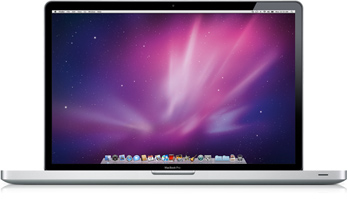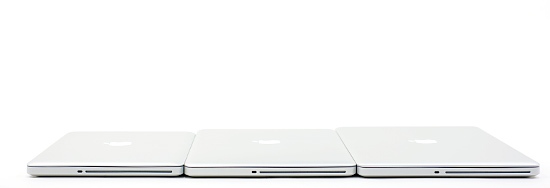Done for 2009: The Holiday MacBook Pro Roundup
by Anand Lal Shimpi on November 10, 2009 12:00 AM EST- Posted in
- Mac
And The Story Begins
Traditionally the notebooks with the largest screens are the least attractive, have the worst battery life and are heavy. They're also usually cheaper than their smaller brethren to give people a reason to buy them.
Take a look at what Dell and HP offer with a 17-inch screensize:
| 17.3-inch Notebooks | Dell Studio 17 | HP Pavillion dv7t Quad Edition |
| CPU | Intel Core i7 720QM (1.6GHz, up to 2.8GHz Turbo) | Intel Core i7 720QM (1.6GHz, up to 2.8GHz Turbo) |
| Memory | 4GB DDR3-1066 | 4GB DDR3-1066 |
| HDD | 250GB 7200RPM | 320GB 7200RPM |
| Video | ATI Mobility Radeon HD 4650 1GB | NVIDIA GeForce GT 230M 1GB |
| Optical Drive | 8X Slot Load DL DVD +/-R | 8X Slot Load DL DVD +/-R |
| Screen Resolution | 1600 x 900 | 1600 x 900 |
| Battery | 9-cell 85Whr | 8-cell ??WHr |
| Dimensions (W x D x H) | 16.28" x 11.04" x 1.1" - 1.54" | 16.2" x 10.9" x 1.37" - 1.70" |
| Weight | 7.08 lbs (6-cell battery) | 7.74 lbs |
| Price | $1099 | $1069.99 |
In both cases you're looking at over 1" thick at the thinnest point, and in the case of the HP system it goes up to 1.7" thick. Both machines start at 7 lbs and don't offer higher than 1080p resolutions. In fact, all the larger screen is useful for is reducing DPI as you can get the same resolution screen in 15-inch and 16" models. The hardware is usually fast and affordable, both machines cost less than $1000.
The 17-inch MacBook Pro is a bit different.

At 0.98" thick, it's only 0.03" thicker than the 13-inch or 15-inch MacBook Pro. And that's a constant thickness from front to back. The impact on how it feels is tremendous. It's the first 17-inch notebook I've used that doesn't make me want to laugh at first sight. It honestly just looks and feels like a slightly bigger 15-inch machine.
| 17.3-inch Notebooks | Apple 17-inch MacBook Pro | HP Pavillion dv7t Quad Edition |
| CPU | Intel Core 2 Duo 2.8GHz | Intel Core i7 720QM (1.6GHz, up to 2.8GHz Turbo) |
| Memory | 4GB DDR3-1066 | 4GB DDR3-1066 |
| HDD | 500GB 5400RPM | 320GB 7200RPM |
| Video | NVIDIA GeForce 9400M (integrated) + NVIDIA GeForce 9600M 512MB (discrete) | NVIDIA GeForce GT 230M 1GB |
| Optical Drive | 8X Slot Load DL DVD +/-R | 8X Slot Load DL DVD +/-R |
| Screen Resolution | 1920 x 1200 | 1600 x 900 |
| Battery | 95Whr | 8-cell ??WHr |
| Dimensions (W x D x H) | 15.47" x 10.51" x 0.98" | 16.2" x 10.9" x 1.37" - 1.70" |
| Weight | 6.6 lbs | 7.74 lbs |
| Price | $2499 | $1069.99 |
It’s also Apple’s most expensive notebook. Starting at $2499, it’s more expensive than the 27” iMac and doesn’t even come with a quad-core processor. You’re paying for the screen size, as you can get the same hardware in the 15” MacBook Pro.
The added size is used for one purpose: a higher screen resolution. Apple offers a single display option with the 17-inch machine: a native 1920 x 1200 panel. It's a 16:10 aspect ratio panel, measuring 17-inch on the diagonal, resulting in a pixel density of 133.2 pixels per inch (PPI).
| 17.3-inch Notebooks | Pixels per Inch |
| Apple 13-inch MacBook Pro | 113.5 |
| Apple 15-inch MacBook Pro | 101.6 |
| Apple 17-inch MacBook Pro | 133.2 |
| Apple 27-inch iMac | 108.8 |
| Apple 30-inch Cinema Display | 101.6 |
| 15-inch 1080p Panel | 141.2 |
That’s more than a 30” display. That's more than the 27" iMac. That's more than any other 17-inch notebook on the market today. Only the 15-inch 1080p panels offer a higher pixel density at 141.2 PPI. It's sharp.
Apple makes the 17-inch MacBook Pro very work-focused, you get a ton of desktop space in a package that's honestly not bulky. I can't stress how pleasant it is to carry around; at a constant thickness of less than 1" it really feels a lot smaller than it is. It's the only 17-inch notebook I'd be willing to take with me.

From left to right: 13-inch, 15-inch, 17-inch MacBook Pro. Note the constant height.
The 17-inch MacBook Pro was the first to use Apple's integrated batteries out of necessity. Apple wanted to build a slim, attractive 17-inch MacBook Pro, and cutting down on battery volume enabled that. A side effect was that the 17-inch model has impressive battery life.
Paired with a 95Whr battery, Apple promised up to 8 hours of battery life - a realistically attainable figure as you'll soon see.
From a hardware perspective the 17” isn’t that much different from the rest of the lineup. The system starts with a NVIDIA GeForce 9400M chipset, adds a separate GeForce 9600M for GPU intensive workloads (3D games, OpenCL apps, etc...) and gives you the option of either a 2.8GHz or 3.06GHz 45nm Core 2 Duo with a 6MB L2 cache. The vast majority of users will find the 9400M is sufficient for their needs. And paired with Snow Leopard, the 9600M in the off state doesn’t sap as much battery power as it did under Leopard.
The machine starts with 4GB of memory, expandable up to 8, and comes with a 500GB 5400RPM SATA drive. SSDs are still only optional from Apple.
The 17” system doesn’t come with an integrated SD card reader but it is the only MacBook Pro to ship with an ExpressCard/34 slot.

From left to right: Power input, Ethernet, FireWire 800, 3 USB, Mini DisplayPort, Line In, Headphone Out, ExpressCard/34
Mini DisplayPort is the only way to connect to an external display, and unfortunately Apple cheeps out and doesn't supply any adapters with the machine. With a 17-inch 1920 x 1200 panel, you'll probably be fine without one though.
About the only thing that the machine is missing is Nehalem, but that won't come until next year.

From left to right: 13-inch, 15-inch and 17-inch MacBook Pro
The 17” MacBook Pro started a new trend within Apple. Integrate the battery, offer longer battery life and no one will complain. The technology soon waterfalled down to the 15” and 13” models.










115 Comments
View All Comments
nangryo - Saturday, November 14, 2009 - link
Do you realize the PC hardware you mention to replace MAC product is equivalent in price or even worse, more expensive (Adamo, AlienWare) please stop trolling. If you don't like it, don't read it. No one force you to come here and whine like a crybaby.
tuskers - Tuesday, November 17, 2009 - link
I love your argument-- "you bring up competition in a similar price range, so you must be a troll." You're using the traditional PC-versus-Mac argument of "PCs cost less!", except with even less basis.I want to read a fair comparison of Mac versus the competition, not a slaughter of value-designed PCs. Mac very well might be the best out there-- I think it's pretty well conceded that Macs win on battery life, and OS X certainly has those that swear by it. And I'm absolutely fine with those sections of the article.
This simply isn't an Apples-to-apples comparison. I'm not saying the other companies' brands are better-- what I'm saying is, Apple produces products with a specific type of user in mind-- one at the mid-to-upper performance range (in terms of hardware), with as much dedication to form-factor as it has to functionality. Yes, I expect other companies to ask
If I go shopping for a luxury car, I don't compare Lexus to Honda and Chevy, I compare Lexus to Acura and Cadillac. Similarly, I don't compare $1100 computers with $2500 computers. But you don't even need to escalate past $1000 to find the MSI X600 or GX720. Adamos cost more than 13" Macbooks, but they also ship standard with SSDs, higher screen resolution, and slimmer chassis (although with disadvantages as well). The Envy ships with more horsepower in a similar form-factor for slightly more money (much less than some of the disparities in the article).
These are the compare/contrast elements that make for interesting decisions, rather than a "look at the shiny Macs!" article.
I'll take back the implication that this might have been a "sponsored" article, but it's simply the first thought I had after I read it.
The0ne - Thursday, November 12, 2009 - link
As I said earlier it seems Anand is all "giddy" because he got a new toy to play with. That excitement alone causes all sorts of things :D fun things in most cases hahahaI can't help but agree with your comments. After reading others comments I'm not only shock at Anand but at some users supporting the $2500 MacBook to no end. If I had the money or my company allows the spending I would like to have one, of course. But it's really not practical at all when you have so many other choices in the market.
blufire - Wednesday, November 11, 2009 - link
Just released.. may address the excessive battery drain for 64-bit Safari with 32-bit Flash.citan x - Wednesday, November 11, 2009 - link
Why does it feel that there is too much Mac pro coverage? Most of the info on here has already been available. Why a full blown article on them now?Also, why wasn't the new Asus UL80 that was just reviewed compared here. What I would like to know is how the Asus UL80 compares to the 13" Mac when both have an SSD.
The 17" Macbook Pro is nice, but just too expensive.
mitaiwan82 - Wednesday, November 11, 2009 - link
Good article, but the product shots are a bit overexposed for my taste. The MBPs almost blend into the white background of the site.blufire - Wednesday, November 11, 2009 - link
The image of the 15" MBP on page 3 appears to be a 17".Thanks for the article!
JimmiG - Wednesday, November 11, 2009 - link
I hate it how Apple doesn't use the extra space of the 15" and 17" models to put in a better keyboard and a numpad. My 15" HP Probook comes with big, nicely spaced keys that use all the available space, and they even managed to cram in a numpad without making things look cramped or crowded.The 17" Macbook looks absolutely ridiculous with that *huge* emptiness around the tiny keyboard. I see they no longer include a numpad on the keyboard that comes with the iMac, either. I guess it's to show the world that Macs are "fun", while PCs are only used for Excel and stuff...but still, some of use need to be boring from time to time, and then a numpad is a must.
MrPete123 - Wednesday, November 11, 2009 - link
Anand, I heard there were unofficial ways of running MacOS X on standard PCs... would it be possible to do this and do battery tests to see how it handles it? I'm really interested to know what Apple's doing to make their OS so power efficient.Maybe it disallows C-states or something in their BIOS for non-OSX operating systems?
nangryo - Saturday, November 14, 2009 - link
Not, it's not possible, at least in a formal/official benchmark / reporting. Because it would face legal problem etc etc.He may do it unofficially though.